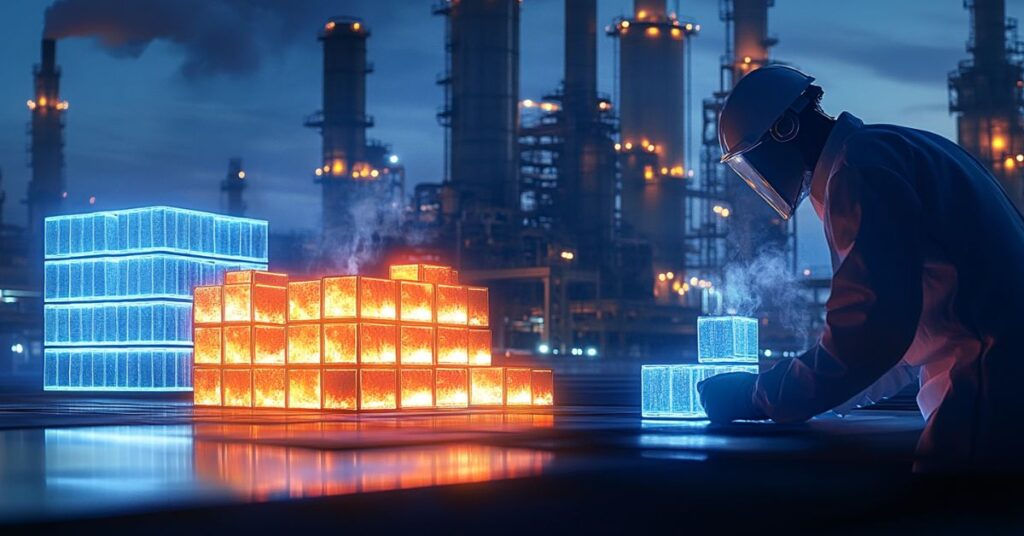Thermal energy, industrial waste utilization, and carbon removal are shaping the future of climate technology. Industries like steel, cement, and chemical manufacturing rely on high-temperature processes that aren’t easily electrified. Addressing these emissions requires innovation beyond renewables. Three recent developments stand out: Sequestra’s CO₂ utilization breakthrough, EPYR’s firebrick thermal storage, and LEGO’s investment in biochar and rock weathering. Together, they highlight the rise of deep tech solutions tackling emissions where simple electrification won’t work.
Scaling CO₂ Utilization in Heavy Industry
Sequestra, a Vienna-based startup, secured €1.1 million in pre-seed funding to advance its CO₂ utilization platform (Garcia, 2025). Instead of relying on traditional carbon capture and storage (CCS), the company’s patented technology binds CO₂ within industrial residues like steel slag, incineration ash, and demolition waste. These carbonated materials can then be used in construction, offering a scalable way to permanently store CO₂ while producing usable building materials.
This approach has two major benefits. First, it turns industrial waste into a revenue-generating product rather than a disposal issue. Second, it addresses concerns about CCS by embedding captured carbon into durable materials rather than requiring long-term underground storage. Sequestra projects that its technology could reduce global CO₂ emissions by 4 to 8.5 billion tons annually, or up to 20% of total industrial emissions. With industrial scaling set for 2025, Sequestra’s model represents a shift toward integrating decarbonization into existing supply chains rather than adding external mitigation steps.
Firebrick Storage: Decarbonizing Industrial Heat
Electrifying heavy industry remains a challenge because many processes require temperatures exceeding what conventional renewables can deliver. EPYR, a French climate tech startup, is tackling this problem with a €3 million investment in high-efficiency thermal energy storage (TES) (Adams, 2025). The company’s firebrick technology converts surplus renewable electricity into heat, storing it for later use in industrial applications.
Industrial heat accounts for 25% of global energy consumption. The challenge is maintaining high temperatures without relying on fossil fuels. EPYR’s system uses heat batteries and AI-driven optimization to manage thermal loads efficiently, reducing peak energy demand and stabilizing grid usage. The funding will be used to launch industrial-scale pilot programs across Europe, demonstrating the economic and operational feasibility of TES at scale.
This solution provides industries with a direct pathway to decarbonization without requiring them to replace core production processes. Instead of shifting to lower-temperature electrified systems, manufacturers can retain high-temperature operations while eliminating fossil fuel dependence. With pilot programs already underway, the success of EPYR’s system could drive broader adoption across energy-intensive sectors like steel, chemicals, and glass production.

LEGO’s Carbon Removal Strategy
LEGO’s £2 million investment in biochar and rock weathering projects reflects a growing focus on natural carbon removal methods (Mace, 2025). The company is partnering with Climate Impact Partners and ClimeFi to support reforestation efforts, biochar production, and enhanced weathering strategies.
Biochar involves converting organic waste into a stable carbon-rich material that can be stored in soil for long-term sequestration. This process locks carbon away for centuries while improving soil fertility and water retention. Rock weathering accelerates the natural breakdown of silicate minerals, pulling CO₂ from the atmosphere and integrating it into soil and water systems.
Unlike direct air capture (DAC), these methods do not require large-scale infrastructure, making them scalable across agricultural and forestry sectors. LEGO’s move aligns with its broader corporate sustainability commitments, including a goal to reach net-zero emissions by 2050. While biochar and rock weathering are not direct substitutes for industrial decarbonization, they complement emerging technologies like Sequestra’s CO₂ utilization and EPYR’s TES by addressing residual emissions that cannot be eliminated through process efficiency alone.
The Next Phase of Industrial Decarbonization
Industries that depend on high-temperature processes represent one of the final frontiers in climate mitigation. While sectors like transportation and power generation have clear electrification pathways, industrial heat and material production require alternative solutions. The rise of deep tech in industrial decarbonization signals a shift from mitigation to integration—embedding carbon management directly into production cycles.
Sequestra’s CO₂ utilization technology transforms industrial waste into carbon-storing materials, offering a market-driven solution to emissions reduction. EPYR’s thermal storage system enables industries to decouple high-temperature processes from fossil fuels, making renewable energy a viable alternative. LEGO’s investment in biochar and rock weathering highlights the role of carbon drawdown in balancing unavoidable emissions.
With these innovations advancing, industrial decarbonization is moving from theory to implementation. Scaling these technologies across industries will determine their true impact. The coming years will reveal whether these solutions remain niche or become fundamental components of global climate strategy.
Follow me on LinkedIn for insights on emerging climate tech solutions and global trends.
References
Adams, L. (2025, February 4). EPYR raises €3M for thermal energy storage. Tech.eu. Retrieved from https://tech.eu/2025/02/04/pyr-raises-3m-for-thermal-energy-storage/
Garcia, D. C. (2025, February 4). Sequestra raises €1.1 million for CO₂ utilisation reduction in heavy industry. EU-Startups. Retrieved from https://www.eu-startups.com/2025/02/sequestra-raises-e1-1-million-for-co2-utilisation-reduction-in-heavy-industry/
Mace, M. (2025, February 4). LEGO turns to biochar and rock weathering for carbon removal efforts. Edie. Retrieved from https://www.edie.net/lego-turns-to-biochar-and-rock-weathering-for-carbon-removal-efforts/




